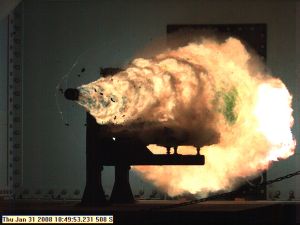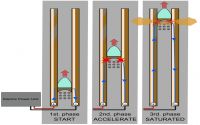A rail gun uses magnetic and electric forces to accelerate a projectile. Parallel rails extend along the length of the firing chamber of the rail gun powered by capacitors. With the power generated by the magnetic fields contained in rail guns, objects can be launched at incredible speeds. The result is a destructive force. The rail gun, though, still has a variety of other applications. Some of these applications are revolutionary and ground breaking. However, there are still many obstacles to overcome. Advancements must be made in rail gun technology. By understanding the physical concepts behind the rail gun, one can grasp the promise that the technology holds.
Introduction
Gunpowder has long been the primary choice of propellant used in firearms since its invention in ancient China. Conventional weapons have been designed based upon the principle of expanding gases to fire projectiles. However, these weapons have physical limitations. Expanding gases can only propel rounds at specific speeds, thus scientists and engineers have been developing a weapon which utilizes a totally new source of propellant: electricity and magnetic forces. This weapon is the rail gun. Although the concept of electric-powered weaponry has been around since the early 20th century, the rail gun has become a reality in recent years.
Design and Theory
A rail gun is essentially an electric circuit which comprises three types of parts: a power source, a pair of rails, and an armature, which is placed on a boat [1]. The power supply provides the rail gun with the needed current to produce the required forces to propel the projectile. Rail guns usually work with currents in the millions of Amperes. For perspective, the average 60-Watt light bulb only contains 0.5 Amperes of current. The parallel rails and the armature are made of conductive metals. The armature is used to bridge the circuit between the two rails to keep current flowing. It also houses the projectile to be fired.
In electricity, current flows from the positive terminal of the battery to the negative terminal [2]. In Fig. 1 of a rail gun circuit, the current flows from the positive terminal of the power source up the positive rail, across the armature, and back down the negative rail to the negative terminal of the power source. Current running through a wire has an intrinsic magnetic field associated with it [2]. In a rail gun, the rails act as the wires of the circuit. Magnetic fields are created around these rails. The magnetic force lines run in a counterclockwise and clockwise direction around the positive and negative rails, respectively. Therefore, in between the two rails, the net magnetic force is upwards.
The projectile is acted upon by the Lorentz Force (F). The Lorentz force is the product of the current (i) flowing through the armature and the magnetic field (B). The Lorentz force is the driving force which propels the projectile. The magnitude of the Lorentz Force is determined by the equation F=i*L*B [2]. As such, the Lorentz Force can be magnified by increasing the current or length (L) of the parallel rails. When the projectile is fired, it exits the ends of the rails. In doing so, the circuit is broken, and all current flow ends.
Power Supply
Rail guns require a large power supply to generate the necessary forces to accelerate the fired projectile. Capacitors need to store enough electric charge until a large enough current has built up [1]. These capacitors usually are many cubic meters in size. A problem arises when a rail gun with a high firing rate (6 rounds/min) requires as much power as needed for ship propulsion [3]. These power requirements can be met with the all-electric warship with an integrated power system (IPS). IPS is a highly efficient electric power generation and distribution system. With this system, a ship will be able to manage its power and switch between the rail gun and propulsion.
Intense Heat
Electric current that passes through conductive material must take resistance into account. Materials usually have an internal resistance. The current excites the molecules of the material, which causes heating [1]. This heat is hot enough to melt the rails of the gun. In order for rail guns to be practical, a solution to this intense heating must be found. Some proposed solutions offer cryogenic cooling or the improvement of the conductivity of the material in the rails. The Navy proposed the idea of using liquid nitrogen or a saltwater heat exchanger to cool the rails in order to avoid the problem of welding.
The armature, which houses the projectile, must be in physical contact with the rails at all times to keep the electric circuit complete. Sometimes, the heat dissipated by the rail gun is hot enough to weld the armature and rails together, leaving the rail gun inoperable. A possible remedy for this problem is Metal Vapor Arcing (MVA) [4]. In this set-up, a thin metal foil is placed on the back of a non-conducting projectile. When current flows through the foil, the foil vaporizes and turns into plasma (ionized gas). The plasma is still conductive, which allows the current to flow through, keeping the circuit intact. However, there are drawbacks to MVA. After several shots, metallic residue would begin to build up on the rails due to the plasma cooling back to a solid state. Until a viable cooling option or design is found, intense heating will be one of the main obstacles in the advancement of rail guns.
Repulsion
The currents in the parallel rails run in opposite directions. The opposing currents give rise to a repulsive force between the rails [2]. This repulsive force is proportional to the magnitude of the current. We are dealing with currents in the millions of amps. It attempts to push the rails apart. Wear and tear on rail guns is a serious issue. Many rail guns break after a few shots, which can be disastrous in regards to the amount of money invested in these guns.
Naval Defense
The most prominent application of rail guns is in the defense sector. Rail guns may change the way sea battles are fought. The Navy is looking at rail guns as a prospective replacement to its current large artillery. The Navy is the logical branch of the armed forces to take on research in rail gun technology. Rail guns require a large power supply that only new naval battleships and destroyers can provide. The Army and Air Force do not have the necessary resources to power rail guns.
Unlike conventional naval guns that rely on explosives, the rail gun delivers damage via kinetic energy. The rail gun has been measured to deliver 33 megajoules of energy in one firing [5]. One megajoule is approximately equal to a one ton car traveling at 100 mph.
The projectiles fired by rail guns are usually Tungsten (chemical element W-74) missiles [1]. These missiles are light and easy to transport on naval ships. The Navy also is developing rounds that do not feature warheads. One benefit of eliminating explosives is safety. Without warheads on board, the threat of self-explosions when under attack is eliminated. Instead, an enemy’s magazine (ammunitions room) can be used against himself. By firing the rail gun directly at an enemy ship’s magazine, the navy can “let his explosives be your explosives” [6].
The warhead-less rounds rely on the high kinetic energy produced from the rail gun [7]. For softer targets such as planes, cars, people, etc., the rounds would have a shotgun-like effect. Upon being fired, the round would dispense thousands of pellets. The high kinetic energy of these pellets would be able to penetrate and destroy most targets. For harder targets such as buildings or bunkers, the round would stay completely intact throughout firing and the kinetic energy of impact would thereby destroy the target.
Another advantage of rail gun weaponry is the high velocities its projectiles have achieved. Rail guns have been measured to fire projectiles at nearly Mach 8 (eight times the speed of sound) [7]. The high velocity projectiles allow for more precise and accurate shots to be made as they are less likely to be affected by wind speed and other factors. The high speed of rail gun firings also allows it to hit its intended targets within minutes. Traditional, subsonic missiles take much longer, which might allow the target to escape before the missile even arrives.
Rail guns also offer the Navy the added benefit of a larger firing radius. A ship with a rail gun on board can hit a target within a 250 mile radius [6]. This would allow naval ships to cover more area and be more effective in defense. The large firing radius also would allow ships to fire at targets from a safe distance without having to fear possible retaliation.
Alternative Energy Sources
One of the most innovative ideas in rail gun technology is in the field of nuclear fusion. Rail guns have been looked at in initiating nuclear fusion reactions. Nuclear fusion occurs when two small nuclei combine to form a large nucleus. This process causes a large release of energy. However, the nuclei must be traveling at high speeds for this to occur. Scientists have proposed using rail guns as a means to achieve these high velocities. The impact of the high velocity nuclei would create extremely high temperatures and pressures, an environment conducive to where fusion could occur [1].
Space Travel
NASA has also looked into the potential uses of rail guns. The Applied Physics Laboratory at Kennedy Space Center is considering the idea of using rail guns to launch shuttles and satellites into orbit [8]. NASA proposes that a spacecraft with scramjets (jet engines in which combustion takes place at supersonic speeds) could be launched using a rail gun [9]. It would be launched horizontally and would use the scramjets to gain lift and reach the upper atmosphere. In this proposal, the rail gun and aircraft would have a similar capacity to a roller coaster. Roller coasters utilize electric tracks to catapult the carts to speeds in excess of 100 mph. The only difference between a roller coaster and a rail gun-assisted launch is the much greater speed required to escape Earth’s gravitational field in the latter.
The rail gun launch system is not meant to replace space shuttles. Instead, it is designated more for unmanned aircraft and satellites [8]. However, researchers agree that the system could be adapted to launch manned shuttles once unmanned missions are successful.
The rail gun could revolutionize space launches and the aerospace industry. NASA is even looking far into the future. The program could potentially be used as the basis for a commercial launch system. Rail guns would save millions of dollars in propellants and allow for more frequent trips. Civilians may one day be able to visit outer space because of rail gun technology.
Conclusion
The rail gun is still in its developmental stages, but the future looks bright. The Navy plans to have the weapon deployed on one of its ships by 2025. In space travel, the technology is advanced enough that tests and modeling can take place in the near future. The design and physical concepts have already broken ground, now a breakthrough needs to occur. One engineer put it best, “We have all the ingredients. Now we just have to figure out how to bake the cake” [9]. Rail guns are no longer the stuff of sci-fi lore. They are now a reality.





